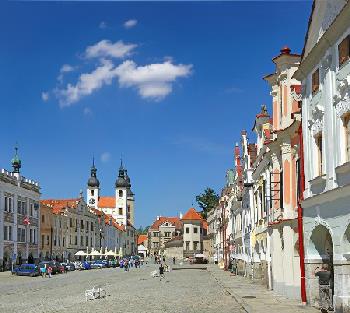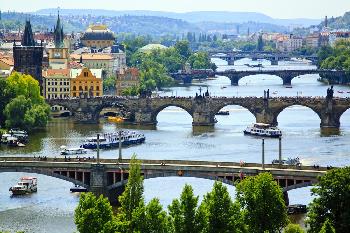find your perfect postgrad program
Search our Database of 30,000 Courses
Study in the Czech Republic
Find courses in the CZECH REPUBLICPLEASE NOTE: As a result of Brexit, from Autumn 2021 postgraduate students from the European Union studying at a UK university will be charged the same tuition fees as international students. Meanwhile, UK students studying their postgraduate course at a European university are also likely to incur higher tuition fees than their EU counterparts. It is advisable to check with the individual universities in the UK and Europe for up-to-date information on tuition fees for all postgraduate programs.
The Czech Republic
 Known as Bohemia from the 9th century to the 18th century, the Czech Republic has been conquered and reformed several times in its long history. The country itself was formed around Prague, its capital, famous throughout history for its culture and endurance, this landlocked country in central Europe can offer international students a truly international experience.
Known as Bohemia from the 9th century to the 18th century, the Czech Republic has been conquered and reformed several times in its long history. The country itself was formed around Prague, its capital, famous throughout history for its culture and endurance, this landlocked country in central Europe can offer international students a truly international experience.
After World War I, the Czech Republic had become Czechoslovakia, a united nation of ethnic Czechs and Slovakians. Under the Nazi occupation, it became the Protectorate of Bohemia and Moravia. With the ousting of the Nazis in the 1940s, the country became a part of the USSR. From 1948 to 1989, what is now the Czech Republic was part of a communist state.
In 1989, it underwent a peaceful transition to democracy known as the “Velvet Revolution”. Shortly afterward, Slovakians peacefully separated to form Slovakia, and the Czech Republic as it currently exists was created.
The currency in the Czech Republic is the Czech Koruna and there are currently approximately 25 Koruna to the Euro.
Czech universities and education
With 600 years of history, Czech Universities are well known for their high standards and academic traditions. The country has mainly public, state-funded institutions, and Czech universities have increasingly shifted towards arts and humanities, but offer a variety of postgraduate level degrees including economics, engineering and vocational programs. A smaller number of schools are private institutions, and many of these are international, catering specifically to foreign students although they are equally accessible to home students as well.
The main language of instruction is Czech, but courses are also offered in English for international students. There are also branches of US universities located in Prague and these cater to international students and provide courses primarily taught in English including the University of New York in Prague, and the Anglo-American University.
If your course is taught in Czech, you may be required to pass an exam that demonstrates your mastery of the language before you can begin your course. Czech Language courses may also be required prior to enrolment.
Many Czech institutions require entrance examinations, which are taken at a later date as part of the application process.
 Tuition fees and funding
Tuition fees and funding
Public universities in the Czech Republic do not charge course fees, and courses taught in Czech are also free of charge. However, if you are taking a course at an international university, or a course taught in English or German, there may be significant tuition fees depending on the type of course and university.
Scholarships
Merit-based scholarships may be available to international students, but these are reserved for students studying on a course taught in Czech. Doctoral students are able to receive stipends in the form of a monthly grant, but this also is dependent on the language of instruction.
Scholarships that cover living costs are available through the Central European Exchange Programme for University Students (CEEPUS), and students should check what awards, bursaries, and fee reductions may be available through individual universities.
Living in the Czech Republic
In terms of being based in Europe, the cost of living in the Czech Republic is very affordable, with lower costs in housing, groceries and rent than any other European country. As of 2008, Prague is the 29th most expensive city in the world, ranked significantly lower than London, Paris and New York.
Students are entitled to an International Student Identity Card which enables them to access discounts on everything from travel costs to trips to the cinema. After obtaining a Job Permit, it’s also possible for international students to find work.
Travel by bus and train is easy and accessible both in and out of major cities with extensive road and rail links in and around Prague, and into and out of the country itself. However, only Prague has a metro system, so underground trains are restricted to within the city limits.
Visas and immigration
Students who are citizens of the EU do not require a visa to study in Czech Republic, but all students need proof of health insurance and EU citizens will also be required to apply for a temporary residence permit for stays of more than 90 days.
Non-EU students will require a visa to study in Czech Republic. A long-term residence permit is necessary to study for a period of more than 90 days. Alongside other documentation, students will need to provide:
1. Proof of acceptance to a Czech University.
2. Proof of financial support.
3. A document from the Criminal Register of the Czech Republic that confirms that you have not been prosecuted for a crime within the national boundary.
4. Proof of health insurance.
Check with your local Czech Republic embassy or with your chosen university to find out what else you need to provide.
A (brief) tour of Prague
 The largest city in the Czech Republic, Prague is also its cultural centre, with the centre of the city itself classified as a UNESCO World Heritage Site. A blend of old and new, modern and historical, Prague has museums, castles, soaring towers and busy streets to offer the discerning tourist and lucky postgrad student alike. There is way too much to see in Prague to summarise it all in one article – so we’ve handpicked a selection of facts, must-sees and must-dos!
The largest city in the Czech Republic, Prague is also its cultural centre, with the centre of the city itself classified as a UNESCO World Heritage Site. A blend of old and new, modern and historical, Prague has museums, castles, soaring towers and busy streets to offer the discerning tourist and lucky postgrad student alike. There is way too much to see in Prague to summarise it all in one article – so we’ve handpicked a selection of facts, must-sees and must-dos!
New structures such as the Dancing House, designed by Milunic and Gehry, which resembles a pair of dancers twirling about above the city street create a unique contrast to the traditional gothic and baroque structures.
Pragues “Old Town” or Staré Mêsto was once surrounded by a wall and a moat that is now buried beneath the city streets. It is the medieval centre of Prague and the original settlement from which the city and the surrounding country formed.
The Charles Bridge connects the Staré Mêsto to Prague Castle, on the other side of the Vltava River. A busy thoroughfare during the day, the bridge is a popular destination for tourists and locals alike. Built in 1357, the bridge has survived several floods, numerous wars and skirmishes, and the test of time.
Wenceslaus Square is large, open rectangular area in the city that is bordered at one end by the Czech National Museum, and at the other by the border between Old Town and New Town. It has long been an important political and economic location in the city, and since the founding of the New Town in 1348, has been home to demonstrations, open air markets and a bustling shopping district. Now lined by shops, restaurants, hotels and office buildings, it still plays a central role in the city’s daily life.
Finally, as the Czechs take enormous pride in their beer – in fact some do say it is their “National Treasure!” – there are numerous bars in Prague that are positively brimming in character and specialize in locally-produced beer – pay some of them a visit and soak in the atmosphere.
Apply for a Postgrad Solutions Study Bursary
